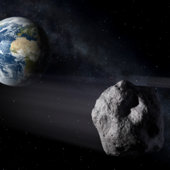
 (82.95 kB)
(82.95 kB)
An image from the SEVIRI instrument aboard Eumetsat's Meteosat-10
geostationary satellite. The vapour trail visible in the centre of the
image was left by an asteroid that struck Earth near Chelyabinsk,
Russia, 15 February 2013, around 03:15 UT. Initial media reports
included accounts of injuries and property loss. This image uses data
from the High Resolution Visible (HRV) channel of SEVIRI that can
produce images with both high spatial and temporal resolution.
A space rock a few metres across exploded in Earth’s atmosphere above
the city of Chelyabinsk, Russia today at about 03:15 GMT. The numerous
injuries and significant damage remind us that what happens in space can
affect us all.
While precise information on the size, mass and composition of the
object are yet to be confirmed, videos show a fireball and explosion
consistent with an asteroid up to a few metres in size exploding in the
atmosphere, possibly several to ten kilometres above the surface.
In this type of event, if the explosion altitude is less than 10 km or
so, the resulting shockwave can cause damage on the ground, such as
shattering windows. Debris from the object may be found later.
“Current information, which is not yet complete nor confirmed, points to
a small asteroid,” said Detlef Koschny, Head of Near-Earth Object
activity at ESA’s Space Situational Awareness (SSA) programme office.
“There is no way it could have been predicted with the technical means available today. What can be said with near certainty is that this object has no connection with asteroid 2012 DA14.”
“There is no way it could have been predicted with the technical means available today. What can be said with near certainty is that this object has no connection with asteroid 2012 DA14.”
Asteroid 2012 DA14 made a close flyby of Earth at 19:27 GMT (20:27 CET) today.
Finding objects that pass close to our planet and are large enough to do
damage if they enter our atmosphere is a major goal of ESA’s SSA
programme.
In addition to conducting its own sky searches using ESA's Optical Ground Station in Tenerife, Spain, SSA is partnering with existing European and international asteroid survey activities.
In addition to conducting its own sky searches using ESA's Optical Ground Station in Tenerife, Spain, SSA is partnering with existing European and international asteroid survey activities.
It also sponsors astronomer groups in Europe, supporting surveys carried
out with their own equipment or allocating observation time on its
Tenerife telescope. The office also provides access to orbit
predictions, close flyby details and related data via its technical
website at http://neo.ssa.esa.int
“Today’s event is a strong reminder of why we need continuous efforts to
survey and identify near-Earth objects,” said Thomas Reiter, ESA’s
Director of Human Spaceflight and Operations.
“Our SSA programme is developing a system of automated optical telescopes that can detect asteroids and other objects in solar orbits.”
“Our SSA programme is developing a system of automated optical telescopes that can detect asteroids and other objects in solar orbits.”
Today’s event is a strong reminder of why we need continuous efforts to survey and identify near-Earth objects.
To achieve this, ESA, European industry and partner agencies are developing a system of automated 1 m-diameter telescopes capable of imaging the complete sky in one night.
In addition to Russian media, who reported immediately, all media worldwide have published images of notable damage around Chelyabinsk, and reports also mention numerous casualties.
“Our most sincere sympathies are with those suffering injury and property loss due to this event in Russia,” added Thomas Reiter.
ESA
RELATED ARTICLES:



Near-miss asteroid will return next year15 March 2012
Guillermo Gonzalo Sánchez Achutegui
ayabaca@gmail.com
ayabaca@hotmail.com
ayabaca@yahoo.com
Inscríbete en el Foro del blog y participa : A Vuelo De Un Quinde - El Foro!

No hay comentarios:
Publicar un comentario